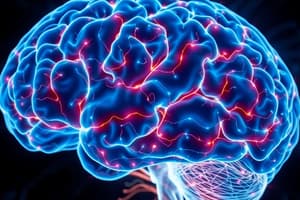Podcast
Questions and Answers
Where is the primary motor cortex located?
Where is the primary motor cortex located?
- Parietal lobe
- Temporal lobe
- Frontal lobe (correct)
- Occipital lobe
Which area of the brain is responsible for planning and coordinating voluntary movements?
Which area of the brain is responsible for planning and coordinating voluntary movements?
- Primary motor cortex (correct)
- Premotor cortex
- Broca's area
- Supplementary motor area
Which fibers connect directly to the motor neurons of the spinal cord in the primary motor cortex?
Which fibers connect directly to the motor neurons of the spinal cord in the primary motor cortex?
- Cerebellar fibers
- Tectospinal fibers
- Pyramidal fibers
- Corticospinal fibers (correct)
Which motor areas do not terminate directly at the spinal cord but control movements indirectly through the brainstem?
Which motor areas do not terminate directly at the spinal cord but control movements indirectly through the brainstem?
What is motor control?
What is motor control?
What is the primary region involved in generating signals for movement?
What is the primary region involved in generating signals for movement?
Which neural pathway connects the motor cortex to the spinal cord?
Which neural pathway connects the motor cortex to the spinal cord?
What is the primary function of the corticospinal tract?
What is the primary function of the corticospinal tract?
What is the role of the primary motor cortex in motor functions?
What is the role of the primary motor cortex in motor functions?
Which part of the brain plays a crucial role in motor learning and skill acquisition?
Which part of the brain plays a crucial role in motor learning and skill acquisition?
Flashcards
Motor Cortex
Motor Cortex
Located in the frontal lobe, it plans and coordinates voluntary movements.
Primary Motor Cortex
Primary Motor Cortex
Located in Brodmann area 4, it generates signals for body movement.
Motor Pathways
Motor Pathways
Neural connections transmitting signals from motor cortex to muscles.
Motor Control
Motor Control
Signup and view all the flashcards
Corticospinal Tract
Corticospinal Tract
Signup and view all the flashcards
Motor Functions
Motor Functions
Signup and view all the flashcards
Somato-cognitive Action Network (SCAN)
Somato-cognitive Action Network (SCAN)
Signup and view all the flashcards
Study Notes
The Motor Cortex: Understanding Primary Motor Cortex, Motor Pathways, Motor Control, Corticospinal Tract, and Motor Functions
The motor cortex is a critical component of the brain's central nervous system, specifically located in the frontal lobe and responsible for planning and coordinating voluntary movements. It consists of three main regions: the primary motor cortex, premotor cortex, and supplementary motor area.
Primary Motor Cortex
The primary motor cortex, situated in Brodmann area 4, plays a central role in generating signals to direct the movement of the body. It is the primary source of corticospinal fibers, which directly connect to motor neurons of the spinal cord. The primary motor cortex is organized in a manner that reflects the body's motor functions, with regions controlling the face, hands, and feet located in their respective areas.
Motor Pathways
Motor pathways refer to the neural connections that transmit signals from the motor cortex to the muscles. The primary motor cortex sends fibers that directly synapse with motor neurons of the spinal cord, while the rostral frontal motor areas do not terminate directly at the spinal cord. Instead, they control movements indirectly through the brainstem via the tectospinal and reticulospinal tracts, which in turn control proximal and axial muscles and movements.
Motor Control
Motor control is the process by which the brain generates, modulates, and integrates signals to produce purposeful movements. The motor cortex is responsible for this process, with the primary motor cortex being the primary region involved in generating signals for movement. These signals are then transmitted via motor pathways to the appropriate muscles.
Corticospinal Tract
The corticospinal tract is a neural pathway that connects the cerebral cortex, specifically the motor cortex, to the spinal cord. It is responsible for transmitting signals from the motor cortex to the motor neurons in the spinal cord, which then activate the muscles. The corticospinal tract is the primary pathway for motor control, allowing the brain to control voluntary movements.
Motor Functions
The motor cortex is involved in various motor functions, including motor planning, execution, and coordination. It controls voluntary actions and plays a role in motor learning and memory, including skill acquisition. Additionally, the motor cortex is responsible for body postural stabilization and coordination.
In recent years, new insights have emerged about the motor cortex, challenging the traditional understanding of its linear organization. Precision fMRI studies have revealed that the motor cortex is organized in a more complex manner, with functionally linked regions called the somato-cognitive action network (SCAN) interspersed among the regions controlling specific movements.
In summary, the motor cortex is a crucial component of the brain's central nervous system, responsible for generating signals to direct the movement of the body. It consists of the primary motor cortex, premotor cortex, and supplementary motor area, with the primary motor cortex being the primary source of corticospinal fibers. The motor cortex controls voluntary actions and plays a role in motor learning and memory, including skill acquisition. The corticospinal tract is the primary pathway for motor control, and the motor cortex is involved in various motor functions, including motor planning, execution, and coordination.
Studying That Suits You
Use AI to generate personalized quizzes and flashcards to suit your learning preferences.




